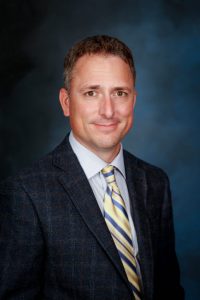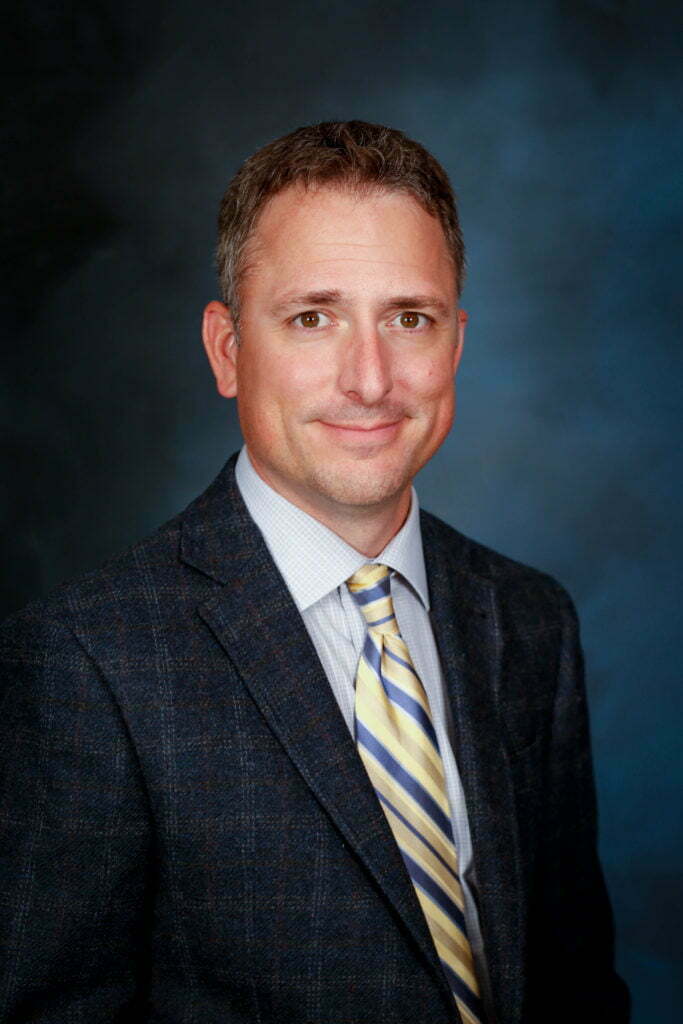By Jeff Kahl, D.D.S., CDA President
From the Summer 2019 Journal of the Colorado Dental Association
 Twelve years ago, I was a first-time delegate to the CDA House of Delegates meeting (the CDA’s governing body with voting representatives from across the state). I’ve been at that meeting and a leader of the CDA in some capacity every year since then. Over these years, I’ve heard a lot of speeches from CDA presidents and as I’ve processed what presidents before me had to offer, I have come to realize that being president isn’t really about what I’m going to accomplish in one year; it’s about setting the stage for all of us to shape the future of organized dentistry.
Twelve years ago, I was a first-time delegate to the CDA House of Delegates meeting (the CDA’s governing body with voting representatives from across the state). I’ve been at that meeting and a leader of the CDA in some capacity every year since then. Over these years, I’ve heard a lot of speeches from CDA presidents and as I’ve processed what presidents before me had to offer, I have come to realize that being president isn’t really about what I’m going to accomplish in one year; it’s about setting the stage for all of us to shape the future of organized dentistry.
I started my journey in organized dentistry not with the CDA but as president of the Colorado Academy of Pediatric Dentistry. My personal agenda then was not much different than it is today: better access, better policy, and better oral health programs for everybody in Colorado regardless of their socioeconomic status. That put me in rooms regularly with oral health coalitions, legislators and state department heads. Many of those groups, particularly some legislators and state employees, did not see the CDA as a favorable ally. In fact, the reputation of the CDA among policy makers was that we were quick to criticize but lacking in alternative solutions. Back then, the CDA did not have the political capital that we have today. That was never more apparent than the first two times we introduced non-covered services legislation (unsuccessfully). (Note: In 2017, the CDA successfully passed Colorado’s non-covered services law.) As a member of the CDA, an organization that I love, it was a bitter pill to swallow realizing that we didn’t really have an ability to influence legislation even when we had the moral high ground.
I’ll remind all of you that hindsight is 20/20. Building up to that point, we didn’t know what we didn’t know. So, we regrouped and faced reality. We changed. We acknowledged that if we were going to be the “recognized authority in oral health” we needed to be more than a loud critic. We needed to BE the force for change. It wasn’t enough to be invited to give our opinions, we needed to be the group pushing forward solutions. We doubled down on our lobby budget, expanded our political action committee, and prepared a robust strategic agenda for our Government Relations Council.
We did A LOT in 10 years. At that time access for children in public programs like Medicaid and CHP+ was not good. Fewer than 50% of kids in Colorado were seen every year (lower than most of the country) primarily because providers weren’t participating—and who would? The policy was confusing, enrollment was onerous, and reimbursement was barely sustainable. However, this was also one of the governor’s “winnable” agenda items at the time. Our work on Medicaid policy and the Take 5 program elevated our status. Suddenly we found ourselves being invited to help design things like the adult Medicaid benefit. As provider participation increased, legislators took notice and were open to fee increases and better administrative policy.
We didn’t stop there. We collaborated with the Colorado Dental Hygienists’ Association to push the virtual dental home, interim therapeutic restorations/ITR, fluoride prescriptive authority, and silver diamine fluoride/SDF scope of care, which continued to demonstrate to legislators and regulators our commitment to push aside differences and work together for Coloradans.
Today, legislators like working with the CDA, because we are a group that has the ability to bring stakeholders together and push forward solutions. Having this more favorable standing has allowed our lobbyists to deflect a lot of unfavorable regulation by either killing bills or opting dentists out of legislation. Today, more than 60% of kids in public programs are seen by a dentist every year. More adults are seen in Colorado as well and our adult Medicaid benefit is considered to be one of the best in the country. The metrics here are better than most of the nation, so it’s no accident that while states around us like Kansas, New Mexico and Arizona are spending millions of member dollars struggling with midlevel provider legislation—Colorado has, in large part, been quiet. The opportunity for a new provider here isn’t as likely because dentists are stepping up to solve the problem with what we already have.
In a decade we flipped the script and positioned ourselves to be one of the most influential oral health champions in the state—simply by changing our mindset. There’s a lot to be proud of. All the volunteers and staff who were involved in that course correction deserve credit for taking the opportunity to shape things into what we have today.
But where do we go from here? Some might sit back and say that this has been enough, we have enough, we’ve built enough, and we are prepared to handle anything in the future. I disagree. I feel like we are at a point in our profession where we again need to take a long hard look at what we think is important and how we want to shape the future—not prevent the future.
Two of the biggest issues we will face are payment reform and an ever-evolving workforce. These are not new topics. But people with more degrees and higher IQs than me feel like the forces driving these discussions are more organized, motivated and better financed than ever before. ADA economists have been putting data in front of groups all over the country with mixed results. I’ve seen firsthand members accusing Harvard trained economists of not knowing what they are talking about. That bothers me, because in order to really affect the outcomes of any of this, we need to, in the very least, understand all of this, and we need to be able to intelligently discuss it from a position at the table.
Organized dentistry philosophically still has a lot of growing to do if we’re going to shape the next 5-10 years. The biggest obstacle to that growth is our own fear and resistance to change. As a group, we have become so narrowly focused on the success of the private practice model, that we’ve lost our view of the big picture. While we’re handwringing over the most minute insurance policy, an earthquake is about to happen that could very well make traditional dental insurance issues look like winning the lottery.
Around 70% of the U.S. population is covered by either public or private dental insurance. We’ve known for a long time that people with dental insurance are more likely to go to the dentist, to take their children to the dentist, to have restorative procedures done, and to have generally better overall oral heath than those without insurance.
So, is a world without insurance even a viable option for us? What’s on the other side? We’re pushing over 200,000 dentists in the U.S. There aren’t enough patients who could afford to get treatment without insurance out there to sustain all of our practices.
So why do we continue to beat ourselves up over it? Why do we hold this up as our gold standard and participate in this game where we sit and look at every procedure that we do, and angst over how much monopoly money we are missing out on because our practices aren’t like a fee-for-service fairy tale?
That’s not to say that the CDA shouldn’t continue to find ways for meaningful insurance reform. But it’s time for us to let go of the fairy tale and start helping dentists be successful in the world that we actually live in.
We’ve been talking about a “formal insurance task force” for about three years. I’m going to ask your CDA Board of Trustees to formally create that group. This group will not be a place for providers who have never accepted insurance or who have an axe to grind. We need members for that group who are in successful insurance practices, people who are willing to become experts in not just dental insurance as it is today but experts in all the models that are going to be coming our way. Payment reform is real and things like the value-based agenda, embedded medical\dental benefits, and a Medicare dental benefit could all be a reality in our practice lifetime. The design of these items is critical. Who is going to push forward models that are meaningful for patients and providers? For our part we can either be prepared to expertly discuss it, or we can sit back and watch it get designed without us. There is no doubt that the worst thing that we could possibly do for future dentists is to bury our heads and pretend that this isn’t happening.
The ever-evolving workforce is also an area that we need to be proactive about. Ten years ago, “corporate dentistry” was often perceived in a negative light. That perception is changing but opinions remain strong because stereotypes and misinformation about non-traditional practice models continue to exist.
Even today, organized dentistry is lacking in resources for dentists working in DSOs, academia or the public health sector. These are expanding demographics. We owe it to our members to better understand these models—how they function, how they would be ideally structured, what kind of benefits and resources that dentists might expect as employees in these models. I believe that soon to be dental graduates and new dentists really want to get an honest view of the landscape that’s available to them. If we take the extra time to learn from each other and focus on what we all have in common as dentists, we can do great things together.
That is my soap box and my charge to you. I don’t have the solutions for all of this. But it’s time for us to stop hiding in the shadow of the past and to march forward into the bright future. We need to take stock of the world where we currently live and prepare ourselves to make it into something better for our patients and our profession. I’m one person and my term is one year. I’m going to do what I can to set these wheels in motion, but it takes more than me; it takes future leaders. They will be the ones who shape our future.
As always, it is my pleasure and honor to serve you.
|
“Do what you can, with what you have, where you are.” – Theodore Roosevelt |


